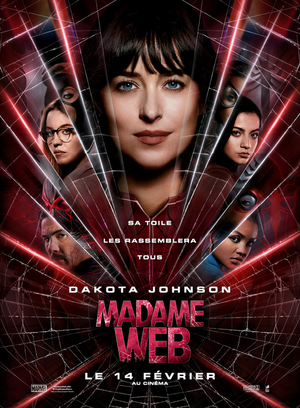The latest film by American director Sarah Adina Smith was released on the Netflix platform on August 27 and we had the chance to see this extraterrestrial, surreal and incredible film that is Buster's Mal Heart. Set in the late 1990s, we follow Buster, a drifter fleeing authorities in the mountains and surviving winter by breaking into empty holiday homes. This man is haunted by visions of himself alone on a boat in the middle of the sea and by memories of his life in 1996: Buster was Jonah, a night concierge in a hotel who could not enjoy his wife and daughter as he wished. One day, Jonah meets an informed conspiracy theorist who will question his universe. In addition to these flashbacks, we also find ourselves facing incomprehensible images of Buster / Jonah alone on a boat in the middle of a totally flat sea. Through Buster 's Mal Heart, we try at every moment to put the pieces of Buster's story together, creating multiple possible timelines in what seems to be the troubled mind of a hermit. But the film goes much further and sends us into the depths of humanity by asking questions of unspeakable power. Check out our review of Sarah Adina Smith's Buster's Mal Heart below.
The freedom of the individual as a central subject
Indeed, the very essence of the film is the notion of freedom and the meaning it can find in the individual. In this very complex film that is Buster's Mal Heart, the character of Jonah, brilliantly played by Rami Malek, is constantly straddling the love he wishes to give to his family and the desire to know true freedom. This questioning of freedom is shown largely through the mysterious character of Brown, played by DJ Qualls, who turns Jonah's vision upside down by telling him about the Second Inversion, a conspiracy theory about the year 2000. After this encounter, our character seems to gradually lose control over his existence and falls of himself into an infernal loop of questions and insurmountable desires.
Buster's Mal Heart therefore highlights the importance of questioning one's own freedom, one's desires, one's needs. The character of Buster as a hermit of the mountains shows a man left to himself, no longer seeking to integrate into a society but rather to understand it by confronting what he thinks are the narrow minds of the members of the system. On the other hand, the Buster in the middle of the sea punishes himself – for what act, we will not specify it so as not to spoil the film – by isolating himself and moving as far away as possible from the society that destroyed him. The two timelines of the Mountain Buster and the Sea Buster intersect, strangely but without actually doing so, giving the viewer the impression of not grasping the chronology of events. However, one detail should be noted: if the two Busters (let's call them that) have each traced their path, neither is happy, but above all neither is free. Throughout the film, Sarah Adina Smith plays with temporalities, loses the viewer and creates a distorted, complex world, in which we plunge head first but whose background we have difficulty seeing.
A very strong link with a passage of the Bible
For connoisseurs of biblical stories, the parallel is quickly striking: Buster's Mal Heart is very clearly inspired by the Book of Jonah , a passage of the Bible sometimes known as the story In the Belly of the Whale. Let's make a very brief summary of what is contained in the Book of Jonah: Jonah, a prophet of God sent to condemn the city of Nineveh, refuses to fulfill the word of God and embarks on a boat to get as far away from Nineveh as possible. A terrible storm hits the ship and the crew deduces that Jonah is the cause of their troubles: the latter is thrown overboard. In the water, he is swallowed by a huge fish (most often represented by a whale) and prays for three days and nights for redemption before being spat out by the animal on a beach. Seeing this as a sign that God was giving him a second chance, Jonah hastened to preach God's word in Nineveh, where he was very badly received.  So he left the city and entered the desert. God, merciful, offered him the opportunity to put himself in the shade of a tree, on condition that Jonah take care of this tree. Once again, the prophet broke his word and the tree died in the night, leaving Jonah to his own fate in the middle of the wilderness.
So he left the city and entered the desert. God, merciful, offered him the opportunity to put himself in the shade of a tree, on condition that Jonah take care of this tree. Once again, the prophet broke his word and the tree died in the night, leaving Jonah to his own fate in the middle of the wilderness.
Director Sarah Adina Smith confirmed that Buster's Mal Heart was not a rewrite of the Book of Jonah but that she was indeed inspired by this biblical account for the character of Jonah , seeking to make him a character "stronger than in the Bible". If you've seen the movie, you'll probably have noticed the phrase uttered by the Buster on the sea: "We are in the belly of the whale." Everything suggests that the two Busters are then metaphorically "in the belly of the whale", a punishment due to Jonah's possible actions in his past life. Many theories about the film imply that it is almost only a comparison with religion and the Book of Jonah, but in truth, there are so many possibilities, so many details to note that we do not know if we will really be able to find a single meaning in the course of the film.
A film worth seeing
 If it is quite complicated to see where the film wants to go once you have seen the end, you must still admit that it is worth seeing. First of all, if we stop on the scenario, it is certainly disjointed and complex, but it is above all very deep. We are placed in front of this character who tries to dig inside himself, who wants somehow to discover the freedom to which he aspires and who must at the same time manage his life and above all, survive his tragic destiny. For the characters, no criticism can be made: the cast is perfect with Rami Malek, DJ Qualls but also Kate Lyn Sheil and Suhka Belle Potter in the roles of Marty and Roxy, Jonah's wife and daughter. In terms of image, we must bow to the incredible talent of Sarah Adina Smith, director, and Shaheen Seth, director of photography. Throughout the film, we are faced with wonderful shots, both in terms of colors and framing: we could for example mention only the shot of the credits, where two silhouettes in backlight face each other on a boat, and this would already give an idea of the work brought to the photography of the film.
If it is quite complicated to see where the film wants to go once you have seen the end, you must still admit that it is worth seeing. First of all, if we stop on the scenario, it is certainly disjointed and complex, but it is above all very deep. We are placed in front of this character who tries to dig inside himself, who wants somehow to discover the freedom to which he aspires and who must at the same time manage his life and above all, survive his tragic destiny. For the characters, no criticism can be made: the cast is perfect with Rami Malek, DJ Qualls but also Kate Lyn Sheil and Suhka Belle Potter in the roles of Marty and Roxy, Jonah's wife and daughter. In terms of image, we must bow to the incredible talent of Sarah Adina Smith, director, and Shaheen Seth, director of photography. Throughout the film, we are faced with wonderful shots, both in terms of colors and framing: we could for example mention only the shot of the credits, where two silhouettes in backlight face each other on a boat, and this would already give an idea of the work brought to the photography of the film.
To conclude this review, we can simply say that Buster's Mal Heart was a real favorite! The film is beautiful, both visually and scriptedly, and the many questions that can be asked at the end only stir up the desire to better understand this film. A tip, do not hesitate to look for explanations on the plot once you have watched the film, you can discover elements that you would not even have imagined having to meet to enter the universe of Jonah. Buster's Mal Heart has been available on Netflix since August 27.









































